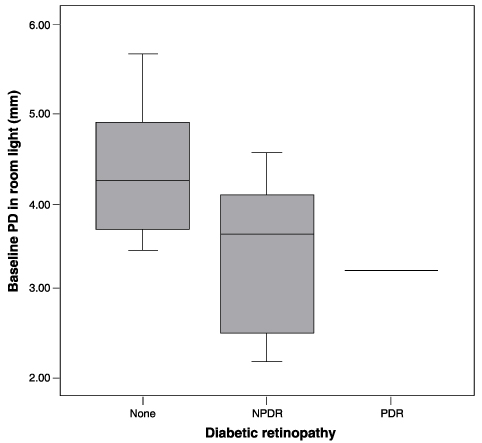Korean J Ophthalmol.
2009 Dec;23(4):291-295. 10.3341/kjo.2009.23.4.291.
A Pharmacologic Pupillary Test in the Diagnosis of Diabetic Autonomic Neuropathy
- Affiliations
-
- 1Department of Ophthalmology, National Health Insurance Corporation Ilsan Hospital, Goyang, Korea. khyeye@hanmail.net
- KMID: 754766
- DOI: http://doi.org/10.3341/kjo.2009.23.4.291
Abstract
- PURPOSE
To screen for diabetic autonomic neuropathy of the pupil using 0.5% apraclonidine and 0.1% pilocarpine and to evaluate the early diagnostic value of this pharmacologic pupillary test by assessing the relationship between pupillary and cardiovascular autonomic neuropathies.
METHODS
A total of 22 diabetic patients were recruited. Baseline pupillary diameter (PD) and the difference in PD between the test eye and the control eye before and after instillation of apraclonidine and pilocarpine were measured. All patients also underwent cardiovascular autonomic function (CAF) testing.
RESULTS
Baseline PD in room light correlated with duration of diabetes mellitus (DM, p=0.049) and the presence of DM retinopathy (DMR, p=0.022). Eleven patients (50%) had positive apraclonidine tests, and two patients had positive pilocarpine tests. The patients who had positive pilocarpine tests also had positive apraclonidine tests. Patients who had a positive pupillary test had a significantly higher rate of positive CAF tests (p=0.032).
CONCLUSIONS
Pupillary autonomic neuropathy was related to the duration of diabetes and the degree of DMR. There was also a significant correlation between pupillary autonomic neuropathy and cardiovascular autonomic neuropathy (CAN). Also, sympathetic nerve dysfunction occurred prior to parasympathetic dysfunction in this study. A simple pharmacologic pupillary test can help manage complications in diabetic patients because patients with pupillary autonomic dysfunction have an increased risk of CAN.
MeSH Terms
-
Adrenergic alpha-Agonists/administration & dosage/diagnostic use
Adult
Aged
Clonidine/administration & dosage/*analogs & derivatives/diagnostic use
Diabetic Nephropathies/*diagnosis/physiopathology
Diagnosis, Differential
Female
Follow-Up Studies
Humans
Male
Middle Aged
Miosis/*chemically induced/physiopathology
Miotics/administration & dosage/diagnostic use
Ophthalmic Solutions
Pilocarpine/administration & dosage/*diagnostic use
Pupil/drug effects/*physiology
Reproducibility of Results
Figure
Reference
-
1. Low PA. Diabetic autonomic neuropathy. Sem Neurol. 1996. 16:143–151.2. Vinik AI, Erbas T. Recognizing and treating diabetic autonomic neuropathy. Cleve Clin J Med. 2001. 68:928–944.3. Ewing DJ, Boland O, Neilson JM, et al. Autonomic neuropathy, QT interval lengthening, and unexpected deaths in male diabetic patients. Diabetologia. 1991. 34:182–185.4. Rathmann W, Ziegler D, Jahnke M, et al. Mortality in diabetic patients with cardiovascular autonomic neuropathy. Diabet Med. 1993. 10:820–824.5. O'Brian IA, McFadden JP, Corrall RJ. The influence of autonomic neuropathy on mortality in insulin-dependent diabetes. Q J Med. 1991. 79:495–502.6. The Diabetes Control and Complications Trial Research Group. The effect of intensive diabetes therapy on the development and progression of neuropathy. Ann Intern Med. 1995. 122:561–568.7. Hreidarsson AB. The pupil of the eye in diabetes mellitus, an indicator of autonomic nervous dysfunction. Dan Med Bull. 1992. 39:400–408.8. Terkildsen AB, Christensen NJ. Reversible nervous abnormalities in juvenile diabetics with recently diagnosed diabetes. Diabetologia. 1971. 7:113–117.9. Purewal TS, Watkins PJ. Postural hypotension in diabetic neuropathy: a review. Diabet Med. 1995. 12:192–200.10. Vinik AI, Ziegler D. Diabetic cardiovascular autonomic neuropathy. Circulation. 2007. 115:387–397.11. Morales J, Brown SM, Abdul-Rahim AS, Crosson CE. Ocular effects of apraclonidine in Horner syndrome. Arch Ophthalmol. 2000. 118:951–954.12. Koc F, Kansu T, Kavuncu S, Firat E. Topical apraclonidine testing discloses pupillary sympathetic denervation in diabetic patients. J Neuroophthalmol. 2006. 26:25–29.13. Cahill M, Eustace P, de Jesus V. Pupillary autonomic denervation with increasing duration of diabetes mellitus. Br J Ophthalmology. 2001. 85:1225–1230.14. Vinik AI, Maser RE, Mitchell BD, Freeman R. Diabetic autonomic neuropathy. Diabetes Care. 2003. 26:1553–1579.15. Bremner FD, Smith SE. Pupil abnormalities in selected autonomic neuropathies. J Neuroophthalmol. 2006. 26:209–219.16. Smith SE, Smith SA, Brown PM, et al. Pupillary signs in diabetic autonomic neuropathy. Br Med J. 1978. 2:924–927.17. Hreidarsson AB. Pupil size in insulin-dependent diabetes: relationship to duration, metabolic control and long-term manifestations. Diabetes. 1982. 31:442–448.18. Schwingshandl J, Simpson JM, Donaghue K, et al. Pupillary abnormalities in type I diabetes occurring during adolescence: comparisons with cardiovascular reflexes. Diabetes Care. 1993. 16:630–633.19. Straub RH, Thies U, Jeron A, et al. Valid parameters for investigation of the pupillary light reflex in normal and diabetic subjects shown by factor analysis and partial correlation. Diabetologia. 1994. 37:414–419.20. Hayashi M, Ishikawa S. Pharmacology of pupillary responses in diabetics - correlative study of the responses and grade of retinopathy. Jpn J Ophthalmol. 1979. 23:65–72.21. Smith SA, Dewhirst RR. A simple diagnostic test for pupillary abnormality in diabetic autonomic neuropathy. Diabet Med. 1986. 3:38–41.22. Smith SA, Smith SE. Evidence for a neuropathic aetiology in the small pupil of diabetes mellitus. Br J Ophthalmol. 1983. 67:89–93.23. Smith SA, Smith SE. Reduced pupillary light reflex in diabetic autonomic neuropathy. Diabetologia. 1983. 24:330–332.24. Barron SA, Rogovski Z, Kanter Y, Hemli Y. Parasympathetic autonomic neuropathy in diabetes mellitus: the heart is denervated more often than the pupil. Electromyogr Clin Neurophysiol. 1994. 34:467–469.25. Pittasch D, Lobmann R, Behrens-Baumann W, Lehnert H. Pupil signs of sympathetic autonomic neuropathy in patients with type 1 diabetes. Diabetes Care. 2002. 25:1545–1550.
- Full Text Links
- Actions
-
Cited
- CITED
-
- Close
- Share
- Similar articles
-
- Pupillary Response Time and Pupillary Area in Korean
- Low tear production in patients with Diabetes Mellitus
- Clinical spectrum and diagnosis of diabetic neuropathies
- Aging Change of Pupil Size in Normal and Diabetic Patients
- Acute Respiratory Arrest and Brain Sequale Ocurred after General Anesthesia in Diabetic Autonomic Neuropathy Patient: A Case Report




